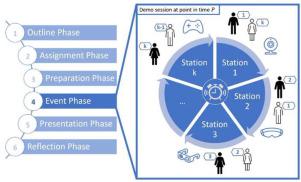Mastering VR/AR Integration: Proven Strategies to Overcome Curriculum Challenges
Virtual reality (VR) and augmented reality (AR) are revolutionizing education by bringing immersive, interactive experiences into the classroom. Yet,integrating these emerging technologies into the curriculum can introduce a variety of challenges. In this thorough guide, we’ll uncover proven strategies to overcome these hurdles, share case studies, and provide practical insights for educators ready to master VR/AR integration.
Why Integrate VR/AR Into Education?
- Enhanced Engagement: Interactive VR/AR experiences boost student motivation and curiosity.
- Experiential Learning: Immersive environments facilitate “learning by doing”, improving retention.
- Accessibility to Complex Concepts: VR/AR can simplify abstract or risky topics, allowing students to visualize molecules or explore hazardous environments safely.
- Personalized education: Adaptive simulations allow students to learn at their own pace.
Common Curriculum Challenges in VR/AR Integration
Despite their transformative potential, educators and institutions face several hurdles when adding VR/AR to their curricula. The moast common challenges include:
- Limited Budget and Resources
- Lack of Technical Expertise
- Curriculum Alignment
- Teacher Training and Buy-in
- Infrastructure Constraints
Proven Strategies to Overcome VR/AR Curriculum Challenges
To ensure successful integration of VR/AR in the classroom, consider these evidence-based strategies:
1.Start Small and Scale Gradually
- Initiate pilot projects or single-classroom implementations before school-wide adoption.
- Identify high-impact subjects (e.g., biology, history, vocational training) where VR/AR can fill existing instructional gaps.
- Collect feedback from both teachers and students to guide further integration.
2. Leverage Cost-Effective Tools
- Choose devices with an optimal price-performance ratio, such as Google Cardboard or affordable AR-enabled tablets.
- Utilize free or low-cost educational VR/AR apps (e.g., Google Expeditions, Merge Cube).
- Explore partnerships with local tech companies or apply for educational technology grants.
3.Align Content with Learning Objectives
- Map VR/AR activities to curriculum standards for measurable learning outcomes.
- Co-create content with subject matter experts to maximize academic relevance.
- Incorporate pre- and post-assessments to monitor progress and efficacy.
4. Empower Educators with Professional Progress
- Conduct training workshops and provide ongoing support for teachers to build confidence and technical proficiency.
- Create peer mentoring systems where early adopters mentor colleagues.
5. Foster a supportive Infrastructure
- Ensure a robust Wi-Fi network and device management system for seamless VR/AR experiences.
- Assign dedicated technical support to address hardware or software issues.
6.Involve Stakeholders Early
- Engage parents, administrators, and community partners to build support and share successes.
- Regularly update stakeholders on progress and collect input to refine your strategy.
Case Studies: Success Stories in VR/AR integration
Real-world examples can offer inspiration and practical insights. Here are two notable case studies:
Case Study 1: High School Science Exploration with VR
Problem: Students struggled to grasp the complexities of cellular biology.
Solution: Teachers integrated a VR journey exploring the inside of a human cell.Using affordable VR headsets and a guided app, students navigated organelles and observed biological processes in action.
Results: Assessments showed a 25% advancement in knowledge retention and increased classroom engagement.
Case Study 2: Remote History Lessons Through AR Artifacts
Problem: Limited access to museum artifacts for remote learning students.
Solution: By partnering with a local museum, teachers used AR applications to project 3D models of artifacts directly into students’ homes. Lessons included guided exploration and interactive quizzes.
results: Virtual attendance rose by 40%, and students reported a more immersive understanding of historical context.
First-Hand educator Experience: Navigating the Transition
“I was hesitant to adopt VR into my physics classes, fearing it would be too technical or distract from core concepts. But with hands-on training, I quickly realized VR helped students visualize forces and motion in ways diagrams never could.The key was starting with just one lesson and building from there.”
- Sarah L., High School Teacher
Key Benefits of Effective VR/AR integration
- Highly immersive learning: Students interact with content in 3D space, fostering deeper understanding.
- Boosts collaboration: Shared virtual spaces and AR initiatives encourage teamwork.
- Catered for diverse learners: Customizable experiences support various learning styles and needs.
- Prepares students for future tech: familiarity with VR/AR platforms offers a competitive edge in STEM fields.
Practical Tips for Seamless VR/AR Curriculum Implementation
- Test all applications before class to minimize technical glitches.
- Create a classroom usage guide for students to follow safety and device care instructions.
- Foster reflection and discussion after each VR/AR experience to cement learning outcomes.
- Continually update resources as new VR/AR educational apps and best practices emerge.
- Encourage creative projects, allowing students to build or present their own VR/AR content as assignments.
Conclusion: Embracing the Future of Learning
Mastering VR/AR integration is not merely about using the latest gadgets, but about reimagining how students interact with knowledge. By understanding the unique challenges of curriculum alignment,investing in training,and starting with purposeful,small-scale projects,educators can harness the full power of these dynamic technologies. As virtual and augmented reality continue to reshape the educational landscape, those who innovate today will be at the forefront of transformative learning tomorrow.

